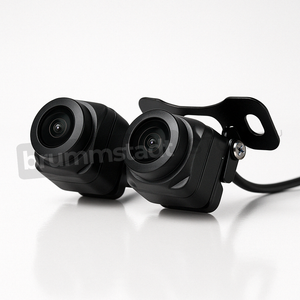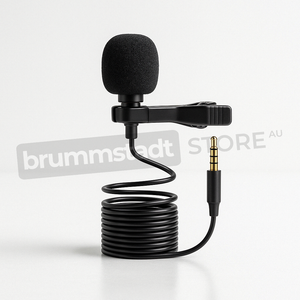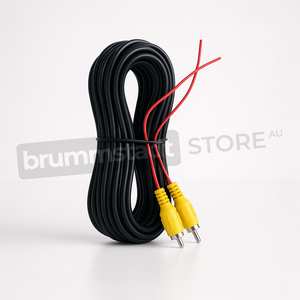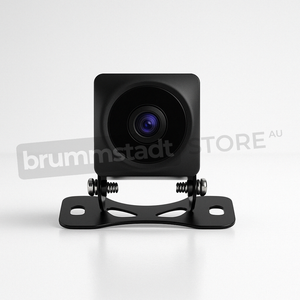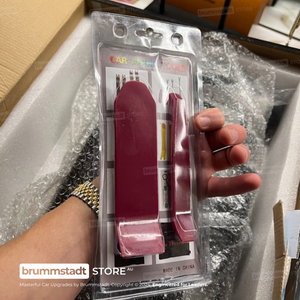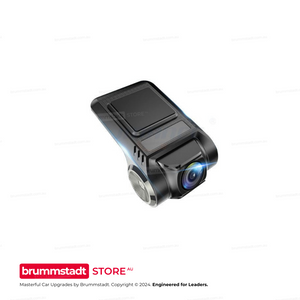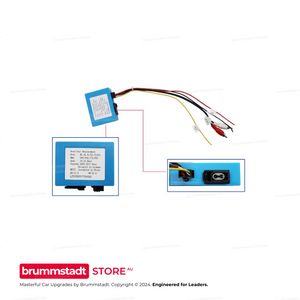Frequently Asked Questions
Everything you need to know about this head unit
Connect the single RCA cable with the yellow plug (included in your package) to extend your Bluetooth signal. This cable doubles as both a camera input AND a Bluetooth/WiFi antenna extension. The two small blue wires attached are antenna boosters that significantly improve connection stability. This simple connection takes 30 seconds and resolves 90% of Bluetooth issues. Make sure it's firmly connected even if you're not using a rear camera.
Try these proven solutions:
1. Quick Fix: Settings → Apps → Z-Link → Disable → Enable → Open (repeat each use)
2. Check Cables: Use the data/charge USB cable (not charge-only)
3. Bluetooth Setting: Disconnect all other Bluetooth connections - CarPlay needs exclusive access
4. Factory Reset Z-Link: Find the pink 'RESET' app, restart, reconnect Bluetooth, then try Z-Link
5. Sound Issues: Switch audio source to 'AUX' or 'USB/AUX' in your vehicle menu
Most issues are resolved with step 1 or 3!
The processor differs between models: The 2/32GB has a 4-Core processor, while 4/64GB and 8/128GB models feature the powerful 8-Core Cortex-A55 processor. Combined with RAM differences: The 2/32GB model with its 4-Core processor and limited RAM may experience slowdowns with heavy multitasking. The 4/64GB with 8-Core provides smooth performance for most users - no lag, seamless app switching, and enough storage for maps and music. The 8/128GB with 8-Core offers maximum performance with its generous RAM allowing unlimited multitasking and massive storage for extensive media libraries. Think of RAM like your desk space - more RAM means you can have more apps open simultaneously without slowing down.
Absolutely normal! These head units are complete replacement systems with their own GPS antenna, microphone, and Bluetooth module. Your factory connectors for these features won't be needed anymore. The important connections are: main power harness, speaker outputs, and the yellow RCA cable (even if not using a camera - it extends Bluetooth range). Any leftover factory plugs can be safely tucked away. If you're unsure about any connection, our support team is here 7 days a week.
Z-Link updates are handled through system firmware updates. Go to Settings → System → System Update. If an update is available, download it to a USB drive (FAT32 format) and install. Important: Never download Z-Link APKs from unofficial sources - they won't work and may cause issues. If you're having compatibility issues with newer iOS versions, the disable/enable workaround (Settings → Apps → Z-Link) usually resolves them while waiting for official updates.
Consider your usage:
• 2/32GB (4-Core): Budget option - fine for basic use, but may lag with multiple apps due to 4-Core processor and limited RAM
• 4/64GB (8-Core): Sweet spot - smooth Android Auto/CarPlay, multitasking, and ample storage
• 8/128GB (8-Core): Premium choice - unlimited multitasking, massive storage, future-proof for years
Most customers choose 4/64GB for the perfect balance of performance and value. The extra RAM makes a huge difference in daily smoothness!
The yellow RCA cable's blue antenna wires also boost WiFi signal! Make sure this cable is connected. Additionally, try these tips: Position the blue antenna wires away from metal surfaces, check that your phone's hotspot is set to 2.4GHz (not 5GHz) for better range, and ensure the head unit's WiFi sleep policy is set to 'Never' in Settings → WiFi → Advanced. For best performance with wireless CarPlay, keep your phone within 1-2 meters of the head unit.
Go to Settings → Sound → Equalizer and adjust to your preference. For more volume, increase the 'Loudness' setting. The 4/64GB and 8/128GB models have superior audio chips that provide cleaner, louder sound. If you have an amplifier, use the RCA outputs for best quality. Also check Settings → Factory Settings (password usually 126) → Audio settings for additional gain controls. Remember: higher-spec models (4GB+) include premium audio components for noticeably better sound.
Yes! Most vehicles work instantly. If not, use the steering wheel learning app: tap the steering wheel icon, press each button on your wheel, and assign functions. For newer vehicles with CANbus, we provide CANbus modules for automatic setup. Some vehicles may need the Key1/Key2 wires connected (usually included in our harness). If you're having trouble, let us know your exact vehicle model and we'll provide specific instructions.
We offer a 30-day return policy. If it doesn't fit or there's a compatibility issue, we'll work with you to resolve it. If you change your mind, a 20% restocking fee applies. Our team verifies compatibility before shipping to minimize issues. We provide installation support 7 days a week to help resolve any problems. With our 3-year warranty and Australian-based support, you can purchase with confidence. Full details in our Refund Policy.
Historical Evolution of Toyota Hilux:
First Generation (1968–1972):
Toyota’s first Hilux debuted as a practical and sturdy pickup truck, targeted towards buyers in need of resilient utility paired with affordable ownership. Compact and reliable, it won immediate favour amongst commercial businesses and individual consumers seeking simplicity combined with robust practicality. Although modestly appointed, the original Hilux set high expectations for future generations through its sheer capability.
Second and Third Generations (1972–1983):
Throughout the 1970s and early 1980s, Toyota refined the Hilux, enhancing its mechanical robustness, expanding powertrain options, and gradually improving passenger comfort. These models became acclaimed for unquestionable durability and ease of maintenance, qualities that established widespread popularity worldwide, particularly in expanding markets across Asia, Africa, Europe, and the Middle East. With each iteration, Hilux grew more accommodating without sacrificing its commercial-oriented ruggedness, cultivating an enduring loyalty among drivers seeking reliability above all else.
Fourth Generation (1983–1988) and Fifth Generation (1988–1997):
During the 1980s and 1990s, Hilux transitioned significantly into a more versatile vehicle offering expanded design choices and improved ride comfort. The addition of more powerful engines, including diesel options known for significant torque and fuel efficiency, further expanded the vehicle's already substantial global appeal. This era notably solidified the model’s presence in demanding working environments, including construction sites and agriculture operations, alongside recreational off-road usage.
Sixth Generation (1997–2004):
In response to evolving consumer demands during the late 1990s into early 2000s, the Hilux began placing greater emphasis on interior quality, driving dynamics, and aesthetic refinement. The sixth generation featured significant redesigns that conveniently balanced practical utilitarian functionality with more comfortable daily usability—a balance broadly appreciated by individual drivers, tradespeople, and fleet customers alike. Its continued offering of economical and powerful diesel engine options especially resonated with international markets, underpinning its already strong reputation.
Seventh Generation (2005–2014):
The 2005 introduction of the seventh-generation Hilux, designated as Hilux AN10, AN20, AN30 (depending on cab-type and drivetrain), marked a profound advancement in design, capability, and cabin sophistication. This generation became the global benchmark, often referred to colloquially as the "Hilux Vigo" in significant regional markets, such as Australia, Southeast Asia, Europe, and Africa. Distinguished by a contemporary and muscular exterior, the seventh-gen Hilux featured increased dimensions, considerably more refined cabin design, and advanced safety assessments. Its robust chassis reinforced this iteration’s credentials as a formidable off-road performer and durable commercial vehicle.
The seventh-generation Hilux included multiple powerful engine choices, most notably the revered D4-D diesel variants, widely praised for their elasticity, towing confidence, fuel efficiency, and extensive reliability under rigorous conditions. Advanced suspension geometry adjustments enhanced ride comfort on paved roads, while maintaining its legendary off-road and towing resilience. Collectively, these substantial mechanical and qualitative improvements established the Hilux as both a durable workhorse and a dependable everyday vehicle respected worldwide.
Technology Integration and Aftermarket Enhancements:
Given the considerable lifespan of the model, many seventh-generation Hilux models now benefit significantly from targeted technological updates. Owners aiming to modernize their driving experience frequently seek feature-rich aftermarket infotainment systems designed specifically to complement the Hilux's cabin and harness modern smartphone connectivity.
Brummstadt offers an ideal premium head unit compatible with 2005–2014 Toyota Hilux models, thoughtfully engineered to integrate naturally with the vehicle’s existing dashboard. With wired and wireless compatibility for Apple CarPlay and Android Auto, the system effectively leverages familiar smartphone interfaces—transforming commutes, entertainment, navigation, and driver-focused functionality.
Imagine an evening spent enjoying a pleasant dinner with friends and family, after which the next destination has already been set through mobile device mapping software. Upon starting the vehicle, the route instantly and automatically mirrors on the head unit display via CarPlay or Android Auto. This simple, smooth interaction effectively eliminates stresses related to manual input, traffic unfamiliarity, or post-meal distractions, immediately summarizing the convenience value of such intelligent upgrades.
Further advancing safety, an optional upgrade introduces high-definition 1080p front and rear recording cameras, adding increased visibility, situational awareness, and valuable recorded evidence in event scenarios. Beyond essential automotive functions, Brummstadt’s system even embraces recreational possibilities. USB-connected controllers allow the head unit screen to become a multiplayer gaming hub, especially valuable over long-distance trips—transforming journeys into delightful family interactions.
Moreover, the intelligent voice-control functionality integrated into the Brummstadt unit further heightens convenience by managing media playback, navigation queries, and communication intuitively—in a hands-free operation ideal for traffic safety. Additionally, this voice activation connects seamlessly to smart home ecosystems. A thoughtful illustration: drivers returning home at night announce, "Hey Siri, turn on the porch lights", further integrating driving experiences with modern digital lifestyle convenience.
Hilux 2005–2014 Driving Experience:
Selecting this Hilux generation, drivers accessed remarkable strength, reliability, comfortable driving ergonomics, adaptable bed configurations, impressive payload capabilities, and consistent ruggedness over uneven terrains. With proven reliability, manageable running costs, versatile axle configurations, and desirable diesel engine options, this particular Hilux forged an unparalleled reputation, becoming synonymous worldwide with vehicle dependability and adaptability.
Expand the vehicle's convenience and enjoyment potential through relevant infotainment upgrades like Brummstadt’s premium head unit, genuinely improving day-to-day usefulness, navigation accuracy, safety oversight, and journey enjoyment for the modern Hilux driver.
The seventh-generation Toyota Hilux thus represents a revered milestone within a long-standing legacy of quality and capability. Thoughtful aftermarket advancements in digital connectivity, multimedia functionalities, driver-assistance systems, and contemporary technological convenience suitably enrich driving interactions. Coupled together, the blend of historically validated mechanical ruggedness from this era with targeted digital modernization provides drivers lasting automotive value, dependable practicality, and reliably memorable ownership experiences.

























































